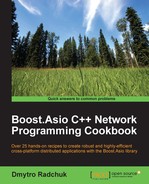In this book, you will find a number of text styles that distinguish between different kinds of information. Here are some examples of these styles and an explanation of their meaning.
Code words in text, database table names, folder names, filenames, file extensions, pathnames, dummy URLs, user input, and Twitter handles are shown as follows: "In Boost.Asio a passive socket is represented by the asio::ip::tcp::acceptor class."
A block of code is set as follows:
std::shared_ptr<boost::asio::ip::tcp::socket> m_sock; boost::asio::streambuf m_request; std::map<std::string, std::string> m_request_headers; std::string m_requested_resource;
When we wish to draw your attention to a particular part of a code block, the relevant lines or items are set in bold:
std::shared_ptr<boost::asio::ip::tcp::socket> m_sock;
boost::asio::streambuf m_request;
std::map<std::string, std::string> m_request_headers;
std::string m_requested_resource;New terms and important words are shown in bold.
..................Content has been hidden....................
You can't read the all page of ebook, please click here login for view all page.
